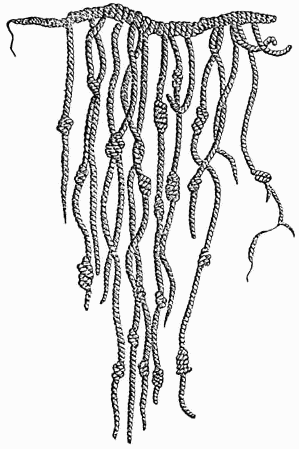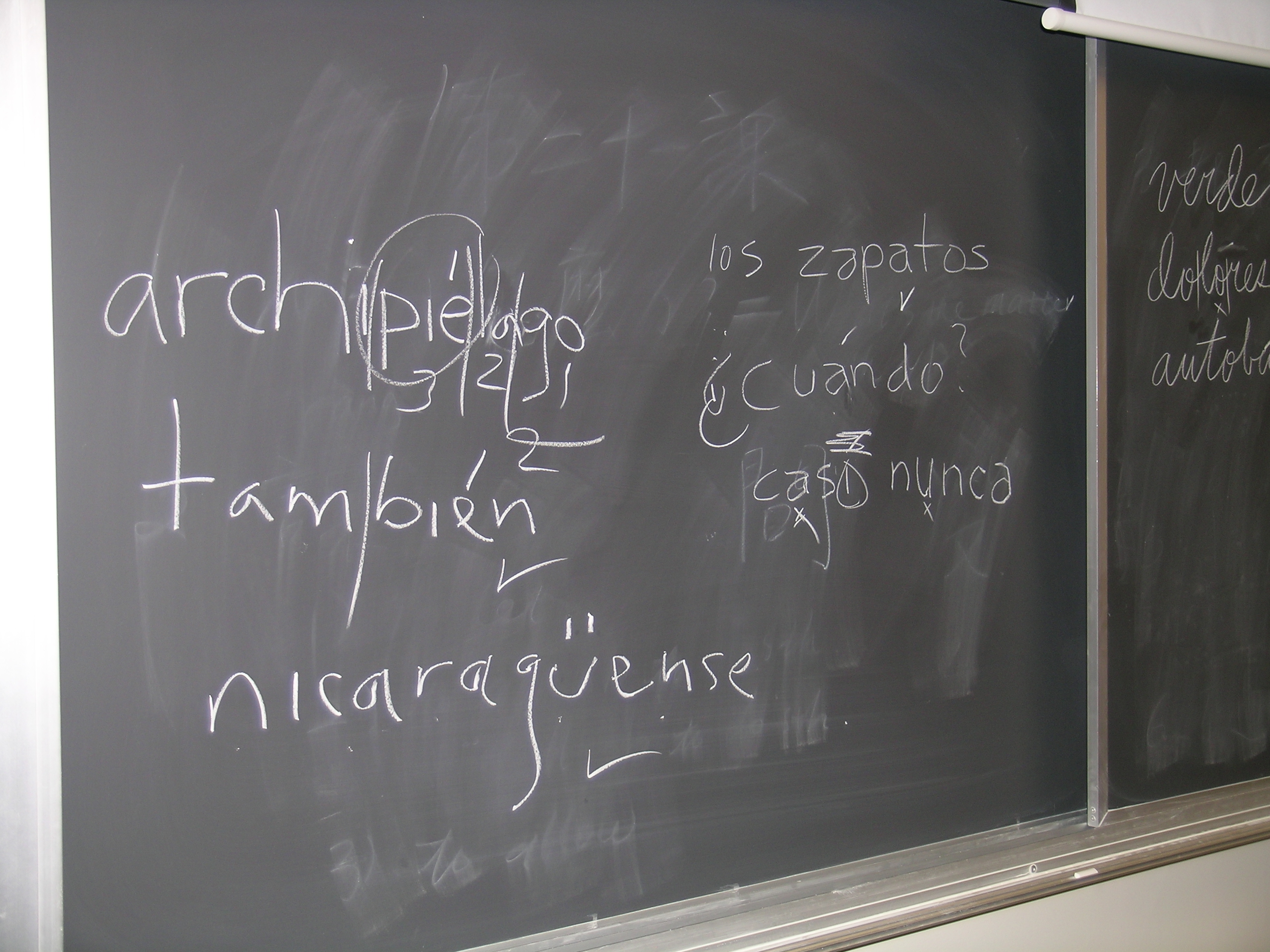|
Quipu
''Quipu'' ( ), also spelled ''khipu'', are record keeping devices fashioned from knotted cords. They were historically used by various cultures in the central Andes of South America, most prominently by the Inca Empire. A ''quipu'' usually consists of cotton or camelid fiber cords, and contains categorized information based on dimensions like color, order and number. The Inca, in particular, used knots tied in a decimal positional system to store numbers and other values in ''quipu'' cords. Depending on its use and the amount of information it stored, a given ''quipu'' may have anywhere from a few to several thousand cords. Objects which can unambiguously be identified as ''quipus'' first appear in the archaeological record during 1st millennium CE,Urton, Gary. (2011). "Tying the Archive in Knots, or: Dying to Get into the Archive in Ancient Peru likely attributable to the Wari Empire. ''Quipus'' subsequently played a key part in the administration of the Kingdom of Cusco of ... [...More Info...] [...Related Items...] OR: [Wikipedia] [Google] [Baidu] |
Inca
The Inca Empire, officially known as the Realm of the Four Parts (, ), was the largest empire in pre-Columbian America. The administrative, political, and military center of the empire was in the city of Cusco. The History of the Incas, Inca civilisation rose from the Peruvian highlands sometime in the early 13th century. The Portuguese explorer Aleixo Garcia was the first European to reach the Inca Empire in 1524. Later, in 1532, the Spanish Empire, Spanish began the conquest of the Inca Empire, and by 1572 Neo-Inca State, the last Inca state was fully conquered. From 1438 to 1533, the Incas incorporated a large portion of western South America, centered on the Andes, Andean Mountains, using conquest and peaceful assimilation, among other methods. At its largest, the empire joined modern-day Peru with what are now western Ecuador, western and south-central Bolivia, northwest Argentina, the southwesternmost tip of Colombia and Incas in Central Chile, a large portion of modern- ... [...More Info...] [...Related Items...] OR: [Wikipedia] [Google] [Baidu] |
Caral–Supe Civilization
Caral–Supe (also known as Caral and Norte Chico) was a complex Pre-Columbian era society that included as many as thirty major population centers in what is now the Caral region of north-central coastal Peru. The civilization flourished between the fourth and second millennia BCE, with the formation of the first city generally dated to around 3500 BCE, at Huaricanga, in the Fortaleza River (Peru), Fortaleza area. From 3100 BCE onward, large-scale human settlement and communal construction become clearly apparent. This lasted until a period of decline around 1800 BCE. Since the early 21st century, it has been recognized as the Cradle of civilization, oldest-known civilization in the Americas, and as one of the six sites where civilization separately originated in the ancient world. This civilization flourished along three rivers, the Fortaleza River (Peru), Fortaleza, the Pativilca, and the Supe. These river valleys each have large clusters of sites. Farther south, there are s ... [...More Info...] [...Related Items...] OR: [Wikipedia] [Google] [Baidu] |
Chinese Knotting
Chinese knotting, also known as (), is a Chinese folk art with ties to Buddhism and Taoism. A Chinese knot is made from a single length of cord that is woven into different shapes, with each shape having a symbolic meaning. The most common color used in Chinese knotting is red, a color Color in Chinese culture, associated with luck in Chinese culture, although any color can be used. Charms, beads, and jade are sometimes incorporated into a Chinese knot. It is believed that Chinese knotting originated for recording information and exchanging messages before writing was commonplace. Traditionally, Chinese knots acted as good-luck charms to ward off evil spirits. Chinese knots are used today to decorate homes during festivities and are also commonly seen in traditional jade jewellery and Chinese clothing, traditional Chinese clothing. Characteristics Chinese knots come in a variety of shapes and sizes. They are made from a single cord and are often double-layered and Symmetry, sy ... [...More Info...] [...Related Items...] OR: [Wikipedia] [Google] [Baidu] |
Gary Urton
Gary Urton (born July 7, 1946) is an American anthropologist. He was the Dumbarton Oaks Professor of Pre-Columbian Studies at Harvard University and the chair of its anthropology department between 2012 and 2019. Urton retired from Harvard in 2020, after multiple former students accused him of sexual harassment. Despite much controversy and opposition, he was given an emeritus title after retirement. Following internal investigation, Urton was stripped of his emeritus status by Harvard in June 2021. Education and career Urton received his B.A. from the University of New Mexico in 1969, and his M.A. and Ph.D. degrees from the University of Illinois Urbana-Champaign in 1971 and 1979, respectively. He was a professor at Colgate University from 1978 to 2002. He is married to artist and anthropologist Julia Meyerson. Urton is a specialist in Andes, Andean archaeology, particularly the quipu (''khipu'') rope-based recording system used in the Inca empire in the 15th and 16th centuries ... [...More Info...] [...Related Items...] OR: [Wikipedia] [Google] [Baidu] |
Spanish Orthography
Spanish orthography is the orthography used in the Spanish language. The alphabet uses the Latin script. The spelling is fairly phonemic orthography, phonemic, especially in comparison to more opaque orthographies like English orthography, English, having a relatively consistent mapping of graphemes to phonemes; in other words, the pronunciation of a given Spanish-language word can largely be predicted from its spelling and to a slightly lesser extent vice versa. Spanish punctuation uniquely includes the use of inverted question and exclamation marks: . Spanish uses capital letters much less often than English; they are not used on adjectives derived from proper nouns (e.g. ''francés'', ''español'', ''portugués'' from ''Francia'', ''España'', and ''Portugal'', respectively) and book titles capitalize only the first word (e.g. ''The Revolt of the Masses, La rebelión de las masas''). Spanish uses only the acute accent over any vowel: . This accent is used to mark the tonic ... [...More Info...] [...Related Items...] OR: [Wikipedia] [Google] [Baidu] |
Quechuan And Aymaran Spelling Shift
In recent years, Peru has revised the official spelling for place-names originating from Aymara and the Quechuan languages. A standardized alphabet for done Quechua was adopted by the Peruvian government in 1975; a revision in 1985 moved to a three-vowel orthography. The major changes are to replace the digraph with the single letter , and to replace the consonants ''c''/''q ' with either or , as appropriate in the word in question. ''K'' and ''q'' represent different sounds in most Andean languages: k is a velar stop , as in Spanish and English; q is a uvular stop . As Spanish does not have uvular , traditional spellings lose this distinction (although sometimes a double ''cc'' was used to represent the k-like sounds of Quechua that differed from the "plain k" sound known in Spanish; e.g., in place names such as Ccarhuacc, Chopcca, Cconocc, Llacce, Manyacc, Chihuilluyocc, Chilcahuaycco, etc.), and Quechua or Aymara sources must be consulted to select the right consonant. ... [...More Info...] [...Related Items...] OR: [Wikipedia] [Google] [Baidu] |
Hispanicized
Hispanicization () refers to the process by which a place or person becomes influenced by Hispanic culture or a process of cultural and/or linguistic change in which something non-Hispanic becomes Hispanic. Hispanicization is illustrated by spoken Spanish, production and consumption of Hispanic food, Spanish language music, and participation in Hispanic festivals and holidays. In the former Spanish colonies, the term is also used in the narrow linguistic sense of the Spanish language replacing indigenous languages. Spain Within Spain, the term "Hispanicization" can refer to the cultural and linguistic absorption of the ethnically Berber Guanches, the indigenous people of the Canary Islands in the century following their subjugation in the 15th century. It is relatively rarely used as a synonym for "Castilianization" (''castellanización'') i.e. the historical process whereby speakers of minority Spanish languages such as Catalan, Basque, Galician, Astur-Leonese or Aragonese are ... [...More Info...] [...Related Items...] OR: [Wikipedia] [Google] [Baidu] |
Andes
The Andes ( ), Andes Mountains or Andean Mountain Range (; ) are the List of longest mountain chains on Earth, longest continental mountain range in the world, forming a continuous highland along the western edge of South America. The range is long and wide (widest between 18th parallel south, 18°S and 20th parallel south, 20°S latitude) and has an average height of about . The Andes extend from south to north through seven South American countries: Argentina, Chile, Bolivia, Peru, Ecuador, Colombia, and Venezuela. Along their length, the Andes are split into several ranges, separated by intermediate depression (geology), depressions. The Andes are the location of several high plateaus—some of which host major cities such as Quito, Bogotá, Cali, Arequipa, Medellín, Bucaramanga, Sucre, Mérida, Mérida, Mérida, El Alto, and La Paz. The Altiplano, Altiplano Plateau is the world's second highest after the Tibetan Plateau. These ranges are in turn grouped into three majo ... [...More Info...] [...Related Items...] OR: [Wikipedia] [Google] [Baidu] |
Nueva Corónica Y Buen Gobierno (1936 Facsimile) P360
{{disambig, geo ...
Nueva is the Spanish feminine form of the word for " new" and may refer to: * Isla Nueva, an uninhabited island in Chile * The Nueva School, a school in Hillsborough, California, USA * Nueva (Llanes), a parish in Llanes, Asturias, Spain * Nueva, a restaurant in Delhi, India by Indian cricketer Virat Kohli Virat Kohli (born 5 November 1988) is an Indian Cricket, international cricketer who plays One Day International, ODI cricket for the India national cricket team, national team and is a former Captain (cricket), captain in all formats. He is a ... [...More Info...] [...Related Items...] OR: [Wikipedia] [Google] [Baidu] |
Urt03
Urt (; ; )AHURTI is a village and a commune in the department in south-western . It is part of the traditional province of |





